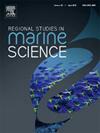Genome diversity of Alteromonas macleodii isolated from the Persian Gulf and the Atlantic Ocean
IF 2.1
4区 环境科学与生态学
Q3 ECOLOGY
引用次数: 0
Abstract
Alteromonas macleodii is a heterotrophic marine bacteria abundant in the water column and associated with marine organisms. However, the genomic repertoire associated with this lifestyle is not completely understood. This study aimed to analyze the genome sequences of A. macleodii obtained from two different environmental conditions, Abrolhos Bank (AB), Brazil, and the Persian Gulf (PG), Iran, from seawater and corals. The genomes of seven Alteromonas strains from AB and three from PG were obtained using Illumina sequencing, ranging from 3 to 4.5 Mb (GC% 44.3–45). Different types and numbers of metal resistance, heat-shock, and salt resistance genes were found in the Alteromonas strains, influenced by their specific environmental conditions. Cultures of PG Alteromonas symbionts produced strong antioxidant activity under laboratory conditions, confirmed by the related gene clusters in their genomes. Additionally, higher secondary metabolites, heavy metal resistance, and chemotaxis gene clusters were found. High temperatures and salinity in the PG favor high absorption rates for heavy metals in corals. Cultivable bacteria from corals might benefit from being adapted to high temperatures, nutrients, and heavy metals. In contrast, the AB strains exhibited a different set of adaptive mechanisms, participating in nutrient cycling, including carbohydrate degradation and metabolic interactions, given the milder environmental conditions of the Atlantic Ocean. The genomic repertoire of A. macleodii strains is consistent with both a free-living and a symbiotic lifestyle, potentially contributing to the health of Abrolhos corals in different ways.
求助全文
约1分钟内获得全文
求助全文
来源期刊

Regional Studies in Marine Science
Agricultural and Biological Sciences-Ecology, Evolution, Behavior and Systematics
CiteScore
3.90
自引率
4.80%
发文量
336
审稿时长
69 days
期刊介绍:
REGIONAL STUDIES IN MARINE SCIENCE will publish scientifically sound papers on regional aspects of maritime and marine resources in estuaries, coastal zones, continental shelf, the seas and oceans.
 求助内容:
求助内容: 应助结果提醒方式:
应助结果提醒方式:


